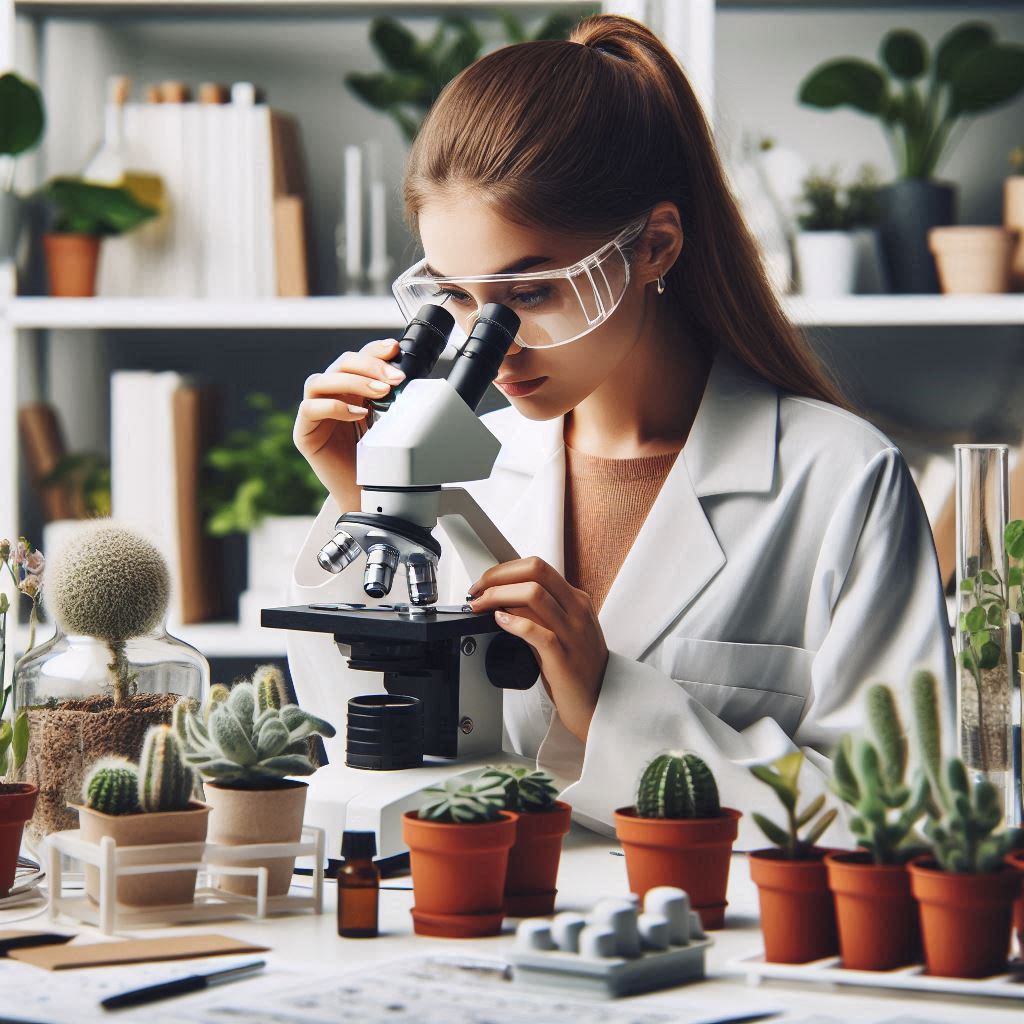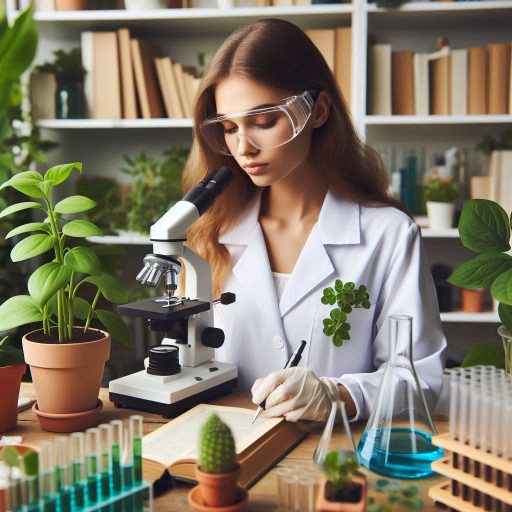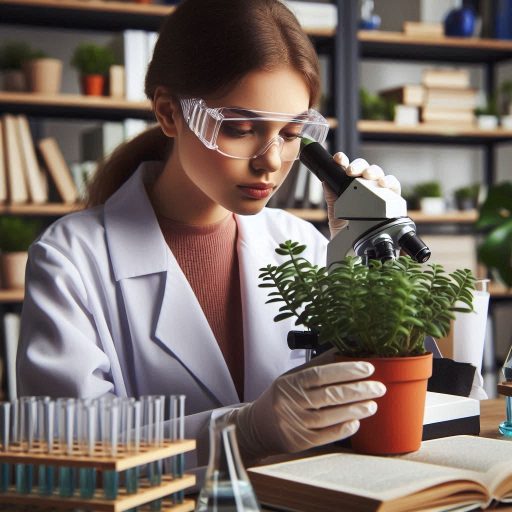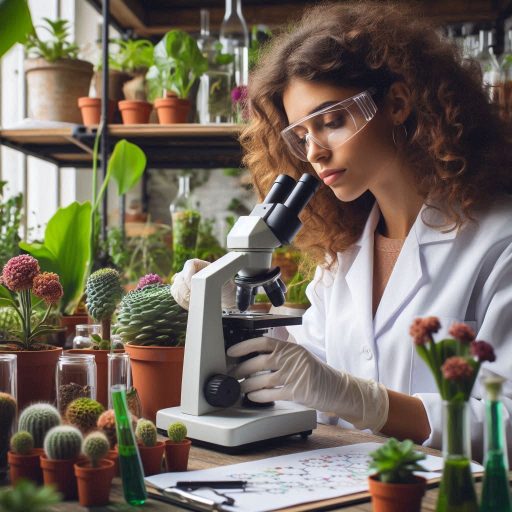Introduction
Modern tools are essential for plant scientists in today’s research landscape.
These tools enhance the efficiency and accuracy of plant studies.
They enable researchers to explore complex biological systems and interactions effectively.
Advancements in technology have significantly transformed plant science, facilitating breakthroughs in crop improvement and sustainability.
Technological innovations, such as high-throughput sequencing, allow for rapid genetic analysis.
Researchers can obtain extensive genomic data quickly, enhancing our understanding of plant traits.
Gene editing technologies, like CRISPR-Cas9, enable precise modifications to plant genomes.
This capability accelerates the development of resilient crop varieties.
Imaging and remote sensing technologies have further revolutionized the field.
Drones and satellites provide real-time monitoring of plant health and growth.
Automated phenotyping platforms streamline the measurement of various traits, saving time and reducing errors.
Additionally, bioinformatics software helps researchers analyze vast datasets efficiently.
This integration of computational tools enhances data interpretation and decision-making processes.
As plant scientists embrace these advancements, they can tackle global challenges more effectively.
The evolution of modern tools empowers researchers to drive innovations in agriculture and improve food security.
Thus, staying updated with technological advancements is crucial for success in plant science.
High-throughput sequencing technologies
High-throughput sequencing (HTS) technologies revolutionize plant science.
They allow researchers to sequence entire genomes quickly and affordably.
These advancements accelerate genetic research, enabling scientists to decode complex plant genomes.
The speed and accuracy of HTS enhance the ability to study plant biology.
Importance of Genomic Data in Plant Research
The importance of genomic data in plant research cannot be overstated.
Genomic data provide critical insights into plant genetics and evolution.
Researchers can identify genes associated with desirable traits, such as disease resistance and drought tolerance.
This information guides breeding programs to develop improved crop varieties.
Furthermore, genomic data facilitate the understanding of plant responses to environmental stresses.
For instance, studying how plants adapt to changing climates becomes easier with comprehensive genomic information.
These insights help in developing resilient crops to combat food security challenges.
Applications of Next-Generation Sequencing in Plant Science
Next-generation sequencing (NGS) plays a significant role in various applications within plant science.
NGS allows for the exploration of transcriptomics, the study of RNA expression levels in plants.
This information helps researchers understand which genes are active under specific conditions.
By analyzing gene expression, scientists can discover how plants respond to environmental changes.
Additionally, NGS supports the field of metagenomics.
Researchers can analyze the complex microbial communities associated with plants.
This analysis provides insights into the role of soil microbiomes in plant health and productivity.
Understanding these interactions helps develop sustainable agricultural practices.
Another application of NGS is in the area of population genomics.
Scientists can study genetic variation within and among plant populations.
This data aids in conservation efforts by identifying genetically diverse populations.
Maintaining genetic diversity is crucial for the long-term survival of plant species.
Furthermore, NGS enables the development of molecular markers for plant breeding.
These markers facilitate marker-assisted selection (MAS), improving breeding efficiency.
Scientists can select plants with desired traits at early developmental stages, speeding up the breeding process.
High-throughput sequencing technologies are vital for modern plant scientists.
They provide genomic data essential for understanding plant biology and evolution.
The applications of next-generation sequencing in plant science are vast and varied.
From transcriptomics to metagenomics, NGS offers valuable insights into plant responses and interactions.
As technology continues to evolve, the impact of these tools on plant research will only grow.
Embracing HTS and NGS will enhance our ability to address global challenges in agriculture and conservation.
Read: U.S. Cities with the Most Opportunities for Environmental Scientists
Gene editing tools (CRISPR-Cas9)
Gene editing tools have transformed plant science.
Among them, CRISPR-Cas9 stands out for its precision and efficiency.
Researchers can use CRISPR to modify specific genes quickly and accurately.
This powerful tool enables scientists to make targeted changes in plant genomes.
Overview of CRISPR Technology
CRISPR-Cas9 technology relies on a natural defense mechanism in bacteria.
Bacteria use CRISPR to protect against viral infections.
Scientists adapted this system for genome editing in various organisms.
The CRISPR system consists of two main components: the guide RNA and the Cas9 protein.
The guide RNA directs the Cas9 protein to a specific DNA sequence.
Once at the target site, Cas9 creates a double-strand break in the DNA.
The plant‘s natural repair mechanisms then kick in to fix the break.
Researchers can harness this repair process to introduce desired changes.
CRISPR technology is user-friendly and cost-effective compared to previous methods.
Its simplicity allows researchers to design specific edits with minimal effort.
This accessibility has led to a surge in CRISPR applications across plant science.
Potential Applications of Gene Editing in Plant Breeding
The potential applications of gene editing in plant breeding are vast.
One significant use is enhancing crop yield and quality.
Scientists can modify genes to improve traits such as growth rate and fruit size.
These enhancements can lead to increased food production.
CRISPR also enables the development of crops with improved resistance to pests and diseases.
By targeting specific genes, researchers can enhance a plant’s natural defenses.
This reduces reliance on chemical pesticides, promoting sustainable agriculture.
Furthermore, gene editing can aid in developing crops that tolerate environmental stresses.
For example, scientists can create drought-resistant plants by modifying water retention genes.
These crops can thrive in changing climates, ensuring food security.
Another exciting application of CRISPR is in the biofortification of crops.
Researchers can increase the nutritional content of staple foods through targeted edits.
This helps combat malnutrition and promotes healthier diets.
Additionally, CRISPR can accelerate the breeding process.
Traditional plant breeding methods often take years to achieve desired traits.
With gene editing, scientists can achieve similar results in a fraction of the time.
This efficiency can lead to quicker adoption of improved crop varieties.
CRISPR-Cas9 technology has revolutionized gene editing in plant science.
Its precision, efficiency, and ease of use make it an invaluable tool.
The potential applications in plant breeding are transformative, from enhancing yield to improving stress tolerance.
As researchers continue to explore CRISPR, the future of plant breeding looks promising.
This technology can address global challenges in agriculture and food security.
Embracing CRISPR-Cas9 will shape the future of sustainable farming practices.
Read: Environmental Scientist vs. Ecologist: Roles and Differences in the US
Imaging tools (confocal microscopy)
Imaging tools play a crucial role in modern plant research.
Among these, confocal microscopy stands out for its precision and versatility.
This technique allows scientists to visualize plant structures in great detail.
Researchers can observe cells and tissues in three dimensions, revealing valuable information.
Importance of Imaging Techniques in Plant Research
Imaging techniques are essential for understanding plant biology.
They enable researchers to study cellular processes and interactions in real time.
By using advanced imaging tools, scientists can explore complex plant systems.
These insights help decipher how plants respond to environmental changes.
Furthermore, imaging techniques facilitate the analysis of plant development.
Researchers can track changes in growth patterns and cellular organization.
This information is vital for understanding plant morphology and development.
Confocal microscopy, in particular, enhances imaging capabilities.
It uses a laser to illuminate specific areas of a sample.
This method reduces background noise and improves image clarity.
The result is high-resolution images that reveal intricate details of plant structures.
Examples of How Confocal Microscopy Can Be Used to Study Plant Structures
Confocal microscopy has numerous applications in studying plant structures.
One common use is analyzing plant cell walls.
Researchers can visualize the composition and arrangement of cell wall components.
This analysis helps understand how cell walls contribute to plant strength and flexibility.
Another application involves studying plant organelles.
Scientists can use confocal microscopy to examine chloroplasts and mitochondria.
This examination reveals their distribution and dynamics within plant cells.
Understanding organelle behavior is crucial for grasping photosynthesis and energy production.
Confocal microscopy also allows for the observation of intracellular processes.
Researchers can track the movement of proteins and other molecules in living cells.
This capability helps elucidate cellular signaling pathways and gene expression patterns.
Additionally, confocal microscopy is valuable in studying plant-pathogen interactions.
Scientists can visualize how pathogens invade plant tissues.
By examining these interactions at the cellular level, researchers can identify plant defense mechanisms.
Moreover, confocal microscopy can aid in exploring plant reproductive structures.
Scientists can study pollen development and fertilization processes in detail.
This research is vital for improving crop yields through better understanding of reproduction.
Imaging tools like confocal microscopy are indispensable in plant research.
They provide high-resolution images that reveal intricate details of plant structures.
The importance of imaging techniques extends to various aspects of plant biology.
From cell walls to organelles, confocal microscopy enhances our understanding of plant systems.
As researchers continue to utilize these advanced techniques, they will uncover new insights into plant health and development.
Embracing confocal microscopy will ultimately contribute to advancements in agriculture and environmental sustainability.
Read: The Relationship Between U.S. Policy & Environmental Scientist Roles

Bioinformatics software
Bioinformatics software plays a vital role in modern plant research.
These tools help scientists analyze complex biological data efficiently.
Researchers generate vast datasets from various experiments, including genomic sequencing and gene expression studies.
Bioinformatics tools simplify the management and interpretation of these large datasets.
Role of Computational Tools in Analyzing Large Datasets
Computational tools are essential for extracting meaningful information from big data.
They enable researchers to perform statistical analyses and visualize data trends.
By applying algorithms, scientists can identify patterns and correlations within the datasets.
This analysis supports hypothesis testing and drives discoveries in plant biology.
Additionally, computational tools facilitate data integration from multiple sources.
Researchers can combine data from genomics, transcriptomics, and metabolomics.
This integration provides a holistic view of plant systems and their interactions.
Understanding these interactions is crucial for developing sustainable agricultural practices.
Moreover, computational tools enhance the speed of data processing.
Traditional methods for data analysis can be time-consuming and labor-intensive.
In contrast, bioinformatics software automates many processes, saving researchers time.
This efficiency allows scientists to focus on interpreting results and making informed decisions.
Examples of Bioinformatics Tools Used in Plant Genomics
Several bioinformatics tools are commonly used in plant genomics.
One popular tool is BLAST (Basic Local Alignment Search Tool).
BLAST allows researchers to compare DNA and protein sequences efficiently.
This tool helps identify homologous sequences and potential functional relationships among genes.
Another essential tool is Genome Annotation Tools.
These tools assist in annotating newly sequenced genomes.
Researchers can identify genes, regulatory elements, and functional motifs within the genomic data.
This information is crucial for understanding gene functions and interactions.
Gene expression analysis tools, such as DESeq2 and edgeR, are also widely used.
These tools help scientists analyze RNA-Seq data to determine differential gene expression.
Researchers can identify genes that respond to specific treatments or environmental conditions.
This information is valuable for studying plant responses to stress.
Additionally, tools like iPhylo and PhyloMaker support phylogenetic analysis.
These tools help researchers construct evolutionary trees based on genomic data.
Understanding the evolutionary relationships among plant species can inform breeding and conservation strategies.
Moreover, metabolic pathway analysis tools like KEGG and MetaCyc provide insights into plant metabolism.
Researchers can explore the biochemical pathways that contribute to plant growth and development.
This knowledge is essential for improving crop traits through metabolic engineering.
Bioinformatics software is indispensable in plant genomics.
These computational tools enable researchers to analyze large datasets effectively.
From sequence alignment to gene expression analysis, bioinformatics tools enhance our understanding of plant biology.
As technology advances, the role of bioinformatics will continue to grow, driving innovations in agriculture and environmental sustainability.
Embracing these tools will empower scientists to address global challenges in food security and biodiversity conservation.
Read: Organizations & Associations for Environmental Scientists in the USA
Find Out More: Exploring Different Branches of Paleontology
Remote Sensing Technologies
Remote sensing technologies have transformed modern agriculture.
These tools enable farmers to monitor crops from a distance.
By using various sensors, researchers can gather data on plant health and environmental conditions.
This technology enhances decision-making in agricultural practices.
Importance of Remote Sensing in Agriculture
Remote sensing is crucial for precision agriculture.
It allows farmers to collect real-time data about their fields.
This information helps identify issues like nutrient deficiencies and pest infestations early.
Early detection leads to timely interventions, improving crop yields and quality.
Additionally, remote sensing contributes to resource management.
Farmers can use this data to optimize water usage and reduce waste.
By analyzing soil moisture levels, they can apply irrigation only where needed.
This approach conserves water and promotes sustainable farming practices.
Moreover, remote sensing technologies support crop monitoring over large areas.
Traditional methods are often time-consuming and labor-intensive.
In contrast, remote sensing provides comprehensive coverage quickly and efficiently.
Farmers can assess their entire fields without physically inspecting each plant.
Transform Your Career Today
Unlock a personalized career strategy that drives real results. Get tailored advice and a roadmap designed just for you.
Start NowApplications of Drones and Satellites in Monitoring Plant Health
Drones play a significant role in monitoring plant health.
They are equipped with various sensors that capture high-resolution images.
These images help identify stressed areas within fields.
Farmers can detect problems such as diseases, pests, or nutrient deficiencies early on.
Multispectral and hyperspectral sensors on drones capture data beyond visible light.
This capability allows researchers to analyze plant health more effectively.
By assessing the chlorophyll content, scientists can determine plant vigor.
This information enables targeted interventions to improve crop performance.
Drones also facilitate precision application of inputs.
Farmers can use drone technology to apply fertilizers and pesticides precisely.
This targeted approach minimizes chemical use and reduces environmental impact.
It promotes sustainable practices while maintaining crop productivity.
Satellites complement drone technology by providing broader coverage.
They can monitor vast agricultural areas and track changes over time.
Satellite imagery helps farmers assess crop conditions and growth stages.
This information supports planning and decision-making throughout the growing season.
Additionally, satellite data assists in yield estimation.
Farmers can use remote sensing data to predict crop yields accurately.
This capability helps them make informed decisions about resource allocation and market strategies.
Understanding potential yields also aids in food security planning.
Remote sensing technologies have revolutionized agriculture.
They enable farmers to monitor plant health efficiently and effectively.
The importance of remote sensing extends to resource management and crop monitoring.
Drones and satellites are essential tools in this process, providing valuable data.
By embracing these technologies, farmers can enhance productivity and sustainability.
The future of agriculture relies on integrating remote sensing into everyday practices.
This approach will drive innovations in food production and environmental stewardship.
Delve into the Subject: Essential Certifications for Bioinformatics Professionals
Phenotyping Platforms
Phenotyping platforms are essential tools in modern plant science.
These systems automate the process of measuring plant traits.
Researchers use them to collect data on various phenotypic characteristics.
This information is crucial for understanding plant performance and traits.
Overview of Automated Phenotyping Technologies
Automated phenotyping technologies utilize advanced sensors and imaging systems.
These tools capture data on plant growth, development, and stress responses.
High-resolution cameras, infrared sensors, and LiDAR systems are commonly used.
Together, they create detailed images and data sets of plant phenotypes.
Researchers can analyze these data sets to identify genetic variations.
By comparing different plant lines, scientists can pinpoint traits of interest.
This process accelerates the selection of desirable traits in breeding programs.
Automated phenotyping minimizes human error and increases data accuracy.
Furthermore, these platforms allow for continuous monitoring of plants.
Researchers can track plant growth over time in controlled environments.
This capability provides insights into how plants respond to varying conditions.
Automated systems enable large-scale experiments that would be challenging manually.
Benefits of Using High-Throughput Phenotyping in Plant Science
High-throughput phenotyping offers numerous benefits in plant research.
First, it significantly increases the speed of data collection.
Researchers can gather vast amounts of data in a short time.
This efficiency allows for rapid analysis and decision-making.
Second, high-throughput phenotyping enhances the precision of measurements.
Automated systems minimize subjective biases in data collection.
Accurate measurements lead to better insights into plant performance and traits.
This precision is vital for identifying subtle variations among plant lines.
Additionally, high-throughput phenotyping enables the study of complex traits.
Researchers can assess multiple traits simultaneously, including growth rate and stress tolerance.
This comprehensive analysis aids in understanding how traits interact.
As a result, scientists can make more informed breeding decisions.
Moreover, these platforms facilitate large-scale field experiments.
Researchers can evaluate thousands of plants simultaneously in diverse environments.
This capability improves the robustness of experimental results.
It also enhances the relevance of findings to real-world agricultural practices.
Furthermore, high-throughput phenotyping supports the integration of genomic data.
Researchers can correlate phenotypic data with genetic information.
This integration helps identify genes associated with specific traits.
Understanding these relationships is crucial for modern breeding programs.
Phenotyping platforms play a vital role in plant science.
Automated phenotyping technologies enhance data collection and analysis.
The benefits of high-throughput phenotyping extend to speed, precision, and complexity.
Researchers can study multiple traits simultaneously, improving breeding efficiency.
As technology advances, phenotyping platforms will continue to transform plant research.
This evolution will drive innovations in crop improvement and sustainability.
Embracing these tools will ultimately enhance food security and agricultural resilience.
Conclusion
Modern plant scientists rely on various essential tools to enhance their research.
High-throughput sequencing technologies provide critical genomic data.
They help researchers understand plant genetics and improve crop resilience.
Gene editing tools, like CRISPR-Cas9, enable precise modifications to plant genomes.
This technology accelerates the development of improved plant varieties.
Imaging tools, such as confocal microscopy, allow detailed observations of plant structures.
They facilitate insights into plant health and development.
Remote sensing technologies, including drones and satellites, help monitor crop conditions.
These tools provide vital information for precision agriculture.
Bioinformatics software plays a crucial role in analyzing large datasets.
It helps researchers interpret complex biological data efficiently.
Automated phenotyping platforms streamline the measurement of plant traits.
They enable scientists to gather and analyze data at scale.
Staying up-to-date with technological advancements is essential for plant scientists.
New tools and techniques continuously reshape the field of plant research.
Embracing these innovations enhances research efficiency and effectiveness.
By leveraging modern tools, researchers can address global challenges in agriculture and sustainability.
This commitment to advancement will drive future discoveries in plant science, ultimately improving food security and environmental health.
[E-Books for Sale]
The Big Book of 500 High-Paying Jobs in America: Unlock Your Earning Potential
$19.99 • 500 High-Paying Jobs • 330 pages
Explore 500 high-paying jobs in America and learn how to boost your career, earn more, and achieve success!
See All 500 High-Paying Jobs of this E-Book
1001 Professions Without a Degree: High-Paying American Jobs You Can Start Now
$19.99 • 1001 Professions Without a Degree • 174 pages
Discover 1001 high-paying jobs without a degree! Unlock career tips, skills, and success strategies for just $19.99!




